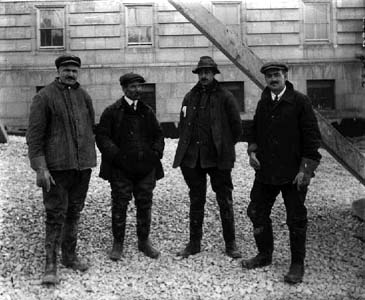Search | Image Archive | Reference | Communities | POV | Lesson Plans | Credits
 One of the legacies of the government of Rodmond Roblin, Premier from 1901 to 1915, was a series of public works, including roads and public buildings, that transformed the face of the province. The darker side of this legacy was the corruption which prevailed in the system under with which many of these buildings and roads were constructed.
One of the legacies of the government of Rodmond Roblin, Premier from 1901 to 1915, was a series of public works, including roads and public buildings, that transformed the face of the province. The darker side of this legacy was the corruption which prevailed in the system under with which many of these buildings and roads were constructed.
This corruption was brought into clear focus by the scandal, which brought about the government's resignation in 1915. In 1913, the government contracted to construct a new Legislative Building. The tender called for a building costing on the order of three million dollars, but this figure quickly grew to five million.
In 1915, in response to rumours about faulty construction, stolen materials, and diversion of public funds into the Conservative election campaign, Fred J. Dixon, an independent MLA, led the call for an investigation of expenditures on the new Legislature. At an investigation by the Public Accounts Committee, Dixon revealed that labourers working at the site had been forced to take a ten per-cent wage cut, while the contractors were expecting to make profits in excess of $60,000. The hearings themselves were complicated by false testimony by civil servants and the absence of the building inspector, who was in the United States on what later proved to be the advice of a cabinet minister. In the end, the Conservative majority of the Committee found no wrong-doing, but the opposition filed a minority report alleging fraud and many other irregularities.
Having gleaned enough evidence from the first investigation, the Liberal opposition made an accusation of fraud of more than $800,000. When Roblin refused to call a Royal Commission of Inquiry, the Liberals petitioned Lieutenant Governor Douglas Cameron who, in a very rare exercise of vice-regal authority, granted the Inquiry. When the Commission bore out the charges levied by the Liberals, Roblin submitted his resignation, and Tobias C. Norris, leader of the Liberal Party, formed a government.
The Legislature scandal was only one example of the corruption of the Conservative party “machine.” The new government resolved to put an end to the corruption and patronage which had been so prevalent under Roblin. In the months and years that followed, investigations were held into other public works. One such investigation was held into the construction of the Law Courts Building and the Provincial Power House, and while no outright fraud was discovered, there had been “unwarranted laxity.” Other investigations found misappropriations in the construction of the Manitoba Agricultural College and the Brandon Mental Hospital, the padding of roadwork accounts for political purposes, and an extensive “kickback” program whereby the amount of government contracts was increased in return for party donations.
In the end, criminal charges against Roblin were dropped on the grounds that he was in ill health. The Royal Commissions were suspended. Most of the monies that were fraudulently obtained were unrecoverable, and it was decided that the public interest was better served by eradicating corruption and rebuilding the civil service than by chasing ghosts. In the decade that followed, partisan government by political machine gave way to reform. In 1917, in response to the call to de-politicize the civil service, Norris created a Civil Service Commission, the first step in the creation of an independent, merit-based public service rather than one reliant on pure patronage.
See also:
Historic Sites of Manitoba: Manitoba Legislative Building (450 Broadway, Winnipeg)
Events in Manitoba History: Royal Commission on Construction of the Legislative Building (1915)
Page revised: 15 March 2019